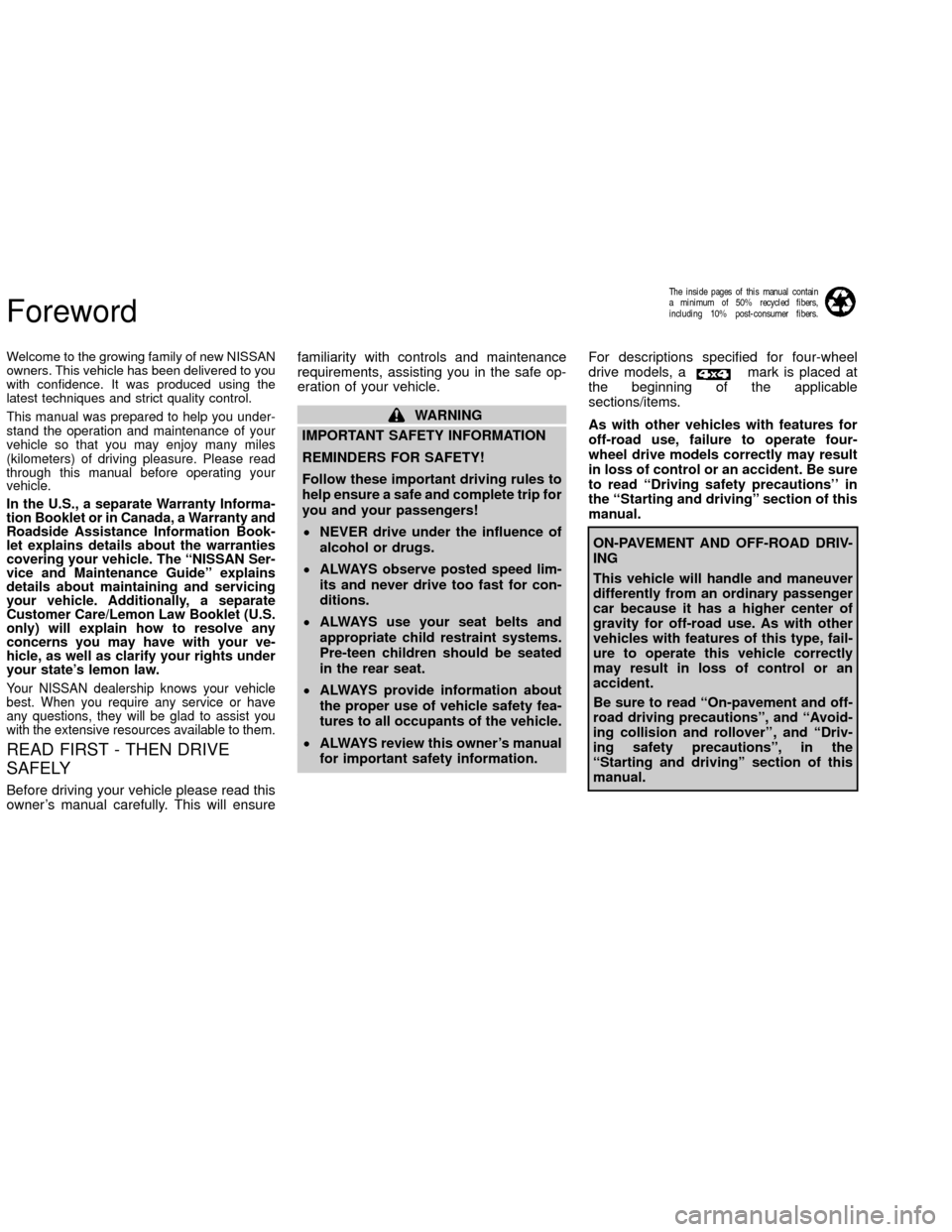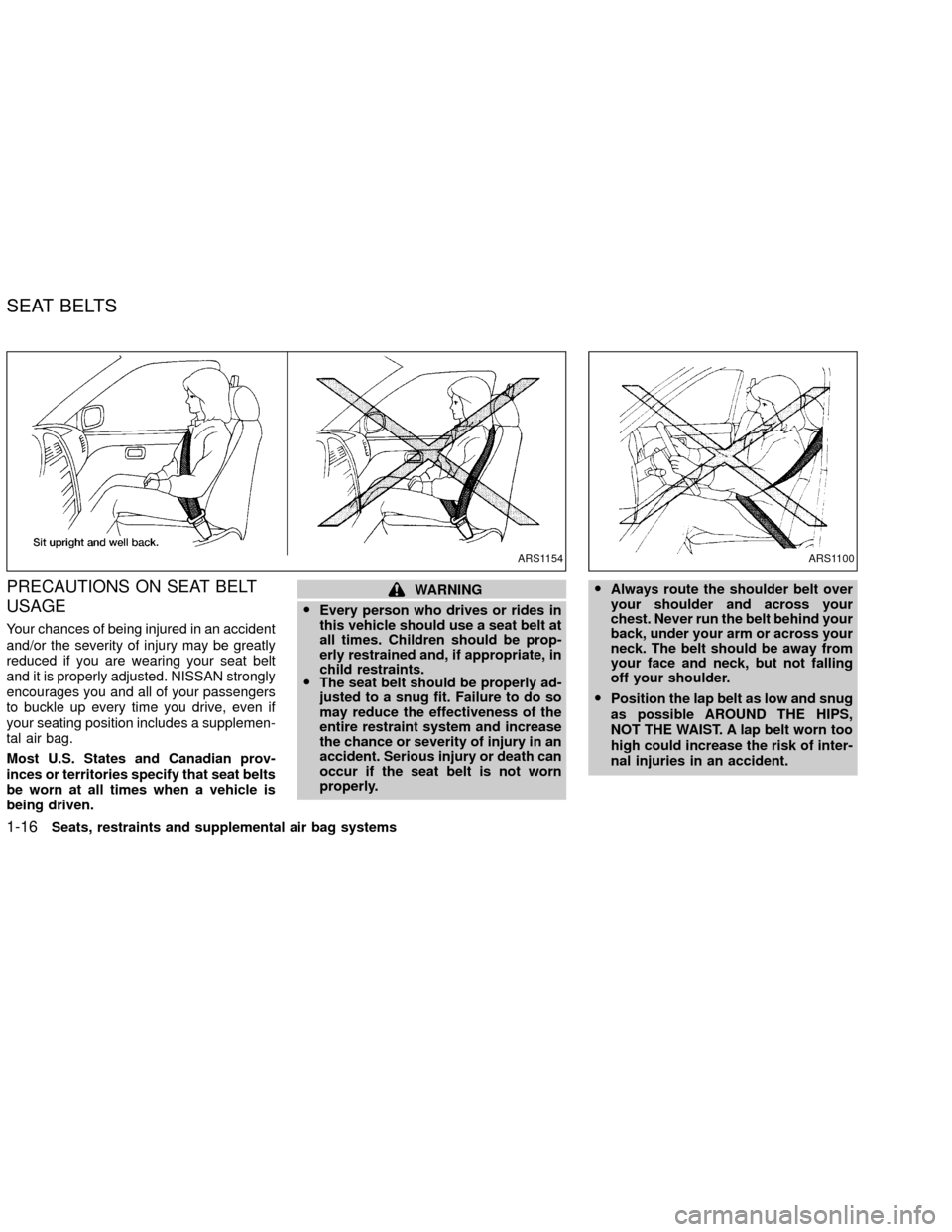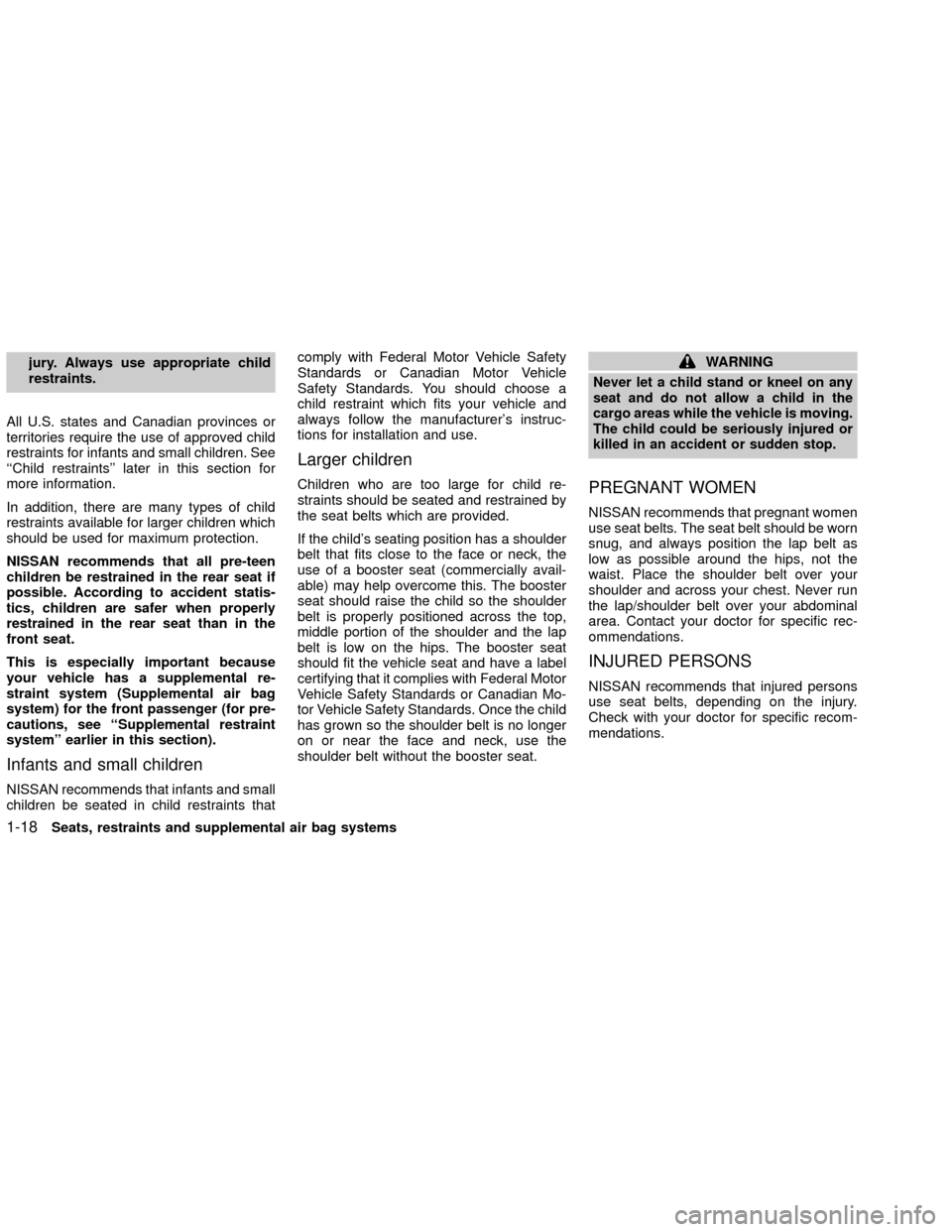2002 NISSAN XTERRA child restraint
[x] Cancel search: child restraintPage 1 of 263

Welcome to the growing family of new NISSAN
owners. This vehicle has been delivered to you
with confidence. It was produced using the
latest techniques and strict quality control.
This manual was prepared to help you under-
stand the operation and maintenance of your
vehicle so that you may enjoy many miles
(kilometers) of driving pleasure. Please read
through this manual before operating your
vehicle.
In the U.S., a separate Warranty Informa-
tion Booklet or in Canada, a Warranty and
Roadside Assistance Information Book-
let explains details about the warranties
covering your vehicle. The ªNISSAN Ser-
vice and Maintenance Guideº explains
details about maintaining and servicing
your vehicle. Additionally, a separate
Customer Care/Lemon Law Booklet (U.S.
only) will explain how to resolve any
concerns you may have with your ve-
hicle, as well as clarify your rights under
your state's lemon law.
Your NISSAN dealership knows your vehicle
best. When you require any service or have
any questions, they will be glad to assist you
with the extensive resources available to them.
READ FIRST - THEN DRIVE
SAFELY
Before driving your vehicle please read this
owner's manual carefully. This will ensurefamiliarity with controls and maintenance
requirements, assisting you in the safe op-
eration of your vehicle.
WARNING
IMPORTANT SAFETY INFORMATION
REMINDERS FOR SAFETY!
Follow these important driving rules to
help ensure a safe and complete trip for
you and your passengers!
²NEVER drive under the influence of
alcohol or drugs.
²ALWAYS observe posted speed lim-
its and never drive too fast for con-
ditions.
²ALWAYS use your seat belts and
appropriate child restraint systems.
Pre-teen children should be seated
in the rear seat.
²ALWAYS provide information about
the proper use of vehicle safety fea-
tures to all occupants of the vehicle.
²ALWAYS review this owner's manual
for important safety information.For descriptions specified for four-wheel
drive models, a
mark is placed at
the beginning of the applicable
sections/items.
As with other vehicles with features for
off-road use, failure to operate four-
wheel drive models correctly may result
in loss of control or an accident. Be sure
to read ``Driving safety precautions'' in
the ``Starting and driving'' section of this
manual.
ON-PAVEMENT AND OFF-ROAD DRIV-
ING
This vehicle will handle and maneuver
differently from an ordinary passenger
car because it has a higher center of
gravity for off-road use. As with other
vehicles with features of this type, fail-
ure to operate this vehicle correctly
may result in loss of control or an
accident.
Be sure to read ªOn-pavement and off-
road driving precautionsº, and ``Avoid-
ing collision and rollover'', and ªDriv-
ing safety precautionsº, in the
ªStarting and drivingº section of this
manual.
The inside pages of this manual contain
a minimum of 50% recycled fibers,
including 10% post-consumer fibers.
Foreword
ZX
Page 8 of 263

1 Seats, restraints and supplemental air
bag systems
Seats ......................................................................1-2
Front manual seat adjustment...........................1-2
Rear seat adjustment (type a)...........................1-3
Rear seat adjustment (type b)...........................1-5
Head restraint adjustment .................................1-7
Supplemental restraint system ...............................1-7
Precautions on supplemental restraint
system ...............................................................1-7
Supplemental air bag warning labels ..............1-14
Supplemental air bag warning light .................1-14
Seat belts .............................................................1-16
Precautions on seat belt usage ......................1-16
Child safety ......................................................1-17
Pregnant women .............................................1-18
Injured persons ................................................1-18Three-point type seat belt with retractor .........1-19
Two-point type seat belt without
retractor (center of rear seat) ..........................1-21
Seat belt extenders .........................................1-23
Seat belt maintenance ....................................1-24
Child restraints .....................................................1-24
Precautions on child restraints ........................1-24
Installation on rear seat center position ..........1-26
Installation on rear seat outboard
positions ..........................................................1-29
Latch (lower anchors and tether for children)
system ..................................................................1-33
Top tether strap child restraint.........................1-35
Installation on front passenger seat ................1-36
ZX
Page 17 of 263

WARNING
ONever let children ride unrestrained.
Do not attempt to hold them in your
lap or arms. Some examples of dan-
gerous riding positions are shown in
the illustrations.
OChildren may be severely injured or
killed when the supplemental air bag
inflates if they are not properly re-
strained.
ONever install a rear-facing child re-
straint in the front seat. An inflating
supplemental air bag could seri-
ously injure or kill your child. See
``Child restraints'' later in this sec-
tion for details.
ARS1043
ARS1044
ARS1098
ARS1099
1-10Seats, restraints and supplemental air bag systems
ZX
Page 23 of 263

PRECAUTIONS ON SEAT BELT
USAGE
Your chances of being injured in an accident
and/or the severity of injury may be greatly
reduced if you are wearing your seat belt
and it is properly adjusted. NISSAN strongly
encourages you and all of your passengers
to buckle up every time you drive, even if
your seating position includes a supplemen-
tal air bag.
Most U.S. States and Canadian prov-
inces or territories specify that seat belts
be worn at all times when a vehicle is
being driven.
WARNING
OEvery person who drives or rides in
this vehicle should use a seat belt at
all times. Children should be prop-
erly restrained and, if appropriate, in
child restraints.
OThe seat belt should be properly ad-
justed to a snug fit. Failure to do so
may reduce the effectiveness of the
entire restraint system and increase
the chance or severity of injury in an
accident. Serious injury or death can
occur if the seat belt is not worn
properly.OAlways route the shoulder belt over
your shoulder and across your
chest. Never run the belt behind your
back, under your arm or across your
neck. The belt should be away from
your face and neck, but not falling
off your shoulder.
OPosition the lap belt as low and snug
as possible AROUND THE HIPS,
NOT THE WAIST. A lap belt worn too
high could increase the risk of inter-
nal injuries in an accident.
ARS1154ARS1100
SEAT BELTS
1-16Seats, restraints and supplemental air bag systems
ZX
Page 24 of 263

OBe sure the seat belt tongue is se-
curely fastened to the proper buckle.
ODo not wear the seat belt inside out
or twisted. Doing so may reduce its
effectiveness.
ODo not allow more than one person
to use the same seat belt.
ONever carry more people in the ve-
hicle than there are seat belts.
O
Never allow anyone to ride in the
cargo area while the vehicle is in
motion. It does not contain seat belts.It is not designed for passengers.
They could be injured in sudden brak-
ing or a collision.
OIf the seat belt warning light glows
continuously while the ignition is
turned ON with all doors closed and
all seat belts fastened, it may indi-
cate a malfunction in the system.
Have the system checked by an au-
thorized NISSAN dealer.
OAll seat belt assemblies including
retractors and attaching hardware
should be inspected by an autho-
rized NISSAN dealer after any colli-
sion. NISSAN recommends that all
seat belt assemblies in use during a
collision be replaced unless the col-
lision was minor and the belts show
no damage and continue to operate
properly. Seat belt assemblies not in
use during a collision should also be
inspected and replaced if either
damage or improper operation is
noted.
OAll child restraints and attaching
hardware should be inspected after
any collision. Always follow the re-straint manufacturer's inspection in-
structions and replacement recom-
mendations. The child restraints
should be replaced if they are dam-
aged.
CHILD SAFETY
Children need adults to help protect them.
They need to be properly restrained.
The proper restraint depends on the child's
size. Generally, infants up to about 1 year
and less than 20 pounds (9 kg) should be
placed in rear facing child restraints. Front
facing child restraints are available for chil-
dren who outgrow rear facing child re-
straints.
WARNING
OInfants and children need special
protection. The vehicle's seat belts
may not fit them properly. The shoul-
der belt may come too close to the
face or neck. The lap belt may not fit
over their small hip bones. In an
accident, an improperly fitting seat
belt could cause serious or fatal in-
ARS1103
Seats, restraints and supplemental air bag systems1-17
ZX
Page 25 of 263

jury. Always use appropriate child
restraints.
All U.S. states and Canadian provinces or
territories require the use of approved child
restraints for infants and small children. See
``Child restraints'' later in this section for
more information.
In addition, there are many types of child
restraints available for larger children which
should be used for maximum protection.
NISSAN recommends that all pre-teen
children be restrained in the rear seat if
possible. According to accident statis-
tics, children are safer when properly
restrained in the rear seat than in the
front seat.
This is especially important because
your vehicle has a supplemental re-
straint system (Supplemental air bag
system) for the front passenger (for pre-
cautions, see ``Supplemental restraint
system'' earlier in this section).
Infants and small children
NISSAN recommends that infants and small
children be seated in child restraints thatcomply with Federal Motor Vehicle Safety
Standards or Canadian Motor Vehicle
Safety Standards. You should choose a
child restraint which fits your vehicle and
always follow the manufacturer's instruc-
tions for installation and use.
Larger children
Children who are too large for child re-
straints should be seated and restrained by
the seat belts which are provided.
If the child's seating position has a shoulder
belt that fits close to the face or neck, the
use of a booster seat (commercially avail-
able) may help overcome this. The booster
seat should raise the child so the shoulder
belt is properly positioned across the top,
middle portion of the shoulder and the lap
belt is low on the hips. The booster seat
should fit the vehicle seat and have a label
certifying that it complies with Federal Motor
Vehicle Safety Standards or Canadian Mo-
tor Vehicle Safety Standards. Once the child
has grown so the shoulder belt is no longer
on or near the face and neck, use the
shoulder belt without the booster seat.
WARNING
Never let a child stand or kneel on any
seat and do not allow a child in the
cargo areas while the vehicle is moving.
The child could be seriously injured or
killed in an accident or sudden stop.
PREGNANT WOMEN
NISSAN recommends that pregnant women
use seat belts. The seat belt should be worn
snug, and always position the lap belt as
low as possible around the hips, not the
waist. Place the shoulder belt over your
shoulder and across your chest. Never run
the lap/shoulder belt over your abdominal
area. Contact your doctor for specific rec-
ommendations.
INJURED PERSONS
NISSAN recommends that injured persons
use seat belts, depending on the injury.
Check with your doctor for specific recom-
mendations.
1-18Seats, restraints and supplemental air bag systems
ZX
Page 26 of 263

THREE-POINT TYPE SEAT BELT
WITH RETRACTOR
WARNING
OEvery person who drives or rides in
this vehicle should use a seat belt at
all times. Children should be prop-
erly restrained and, if appropriate, in
a child restraint.
O
Do not ride in a moving vehicle when
the seatback is reclined. This can be
dangerous. The shoulder belt will not
be against your body. In an accidentyou could be thrown into it and re-
ceive neck or other serious injuries.
You could also slide under the lap belt
and receive serious internal injuries.
OFor most effective protection when
the vehicle is in motion, the seat
should be upright. Always sit well
back in the seat and adjust the seat
belt properly.
Fastening the seat belts
1. Adjust the seat.
2. Slowly pull the seat belt out of the retrac-
tor and insert the tongue into the buckle
until you hear and feel the latch engage.
The retractor is designed to lock during
a sudden stop or on impact. A slow
pulling motion permits the seat belt to
move, and allows you some freedom of
movement in the seat.3. Position the lap belt portionlow and
snug on the hipsas shown.
4. Pull the shoulder belt portion toward the
retractor to take up extra slack.
The front passenger seat belt has a cinch-
ing mechanism for child restraint installa-
tion. It is referred to as the automatic locking
mode.
When the cinching mechanism is activated
the seat belt cannot be extracted again until
the seat belt tongue is detached from the
buckle and the seat belt is fully retracted.
ARS1104ARS1189
Seats, restraints and supplemental air bag systems1-19
ZX
Page 27 of 263

See ``Child restraints '' later in this section for
more information.
The automatic locking mode should be
used only for child restraint installation.
During normal seat belt use by a passen-
ger, the locking mode should not be
activated. If it is activated it may cause
uncomfortable seat belt tension.
Unfastening the seat belts
To unfasten the seat belt, press the button
on the buckle. The seat belt automatically
retracts.
Checking seat belt operation
Seat belt retractors are designed to lock
seat belt movement by two separate meth-
ods:
1) When the seat belt is pulled quickly from
the retractor.
2) When the vehicle slows down rapidly.To increase your confidence in the seat
belts, check the operation as follows.
OGrasp the shoulder belt and pull quickly
forward. The retractor should lock and
restrict further belt movement.
If the retractor does not lock during this
check, or if you have any questions about
seat belt operation, see an authorized
NISSAN dealer.
ARS1054
1-20Seats, restraints and supplemental air bag systems
ZX